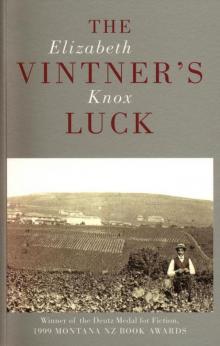- Home
- Elizabeth Knox
Daylight Page 7
Daylight Read online
Page 7
Eve hesitated. She thought of her mother’s cautionary stories about “strange men.” If her mother were still alive she’d be younger than this man. Then Eve thought, But this is Jean Ares. She recognized him as she said his name to herself. Eve even knew the names of his former wives and his famous lovers. In the same instant that she realized who he was, she had his life—or the myth of it—the flash of a shape anyone would immediately recognize. This wasn’t a strange man; this was the artist Ares.
Eve gave him her hand.
Ares had three great periods. In his first, 1925 to 1939, it somehow seemed that the way Europe saw itself altered in answer to his vision. His and others’—but it did seem that it might be possible to tell the story of Western Europe between the wars with one illustrator, Ares. There were collectors and art historians who favored his next great fertile period, 1950 to 1960. His decorative, celebratory, sensual works. It was a period during which he did little painting but produced etchings, sculptural works, and designed the stained glass in a Modernist church in Marseille.
In 1971 Ares was still working and selling his works, but it could be said that he had devolved into an honorable presence. He had commissions for public works. He collaborated. He played with new technology to make prints and print books. Then—said the historians, the curators, and the author of his first biography—Ares met Eve Moskelute. Eve was Ares’s Eurydice, said the biographer; Ares had to play his best, his most heartfelt, in order to move Hades, win death’s clemency, and lead Eve out of the underworld. A picture caption in the biography read: “Eve under the Arches, oil on canvas, 1972. Again and again Ares would try to capture his Eve in the moment he first saw her, in the Roman Storehouse at Arles. Here Eve is a ghost, a quenched soul, a votive candle Ares must light.”
(“A ghost he must lay,” Eve wrote, in 1983, on her copy of the proofs, before posting them back to the biographer.)
With Eve, Ares had six more great years before the obstruction, the operation and chemotherapy, the relapse, the good “managed” death in his own home.
A month before Jean died, Eve went to an art auction. Jean asked her to attend because one of his famous early works was going under the hammer. He was curious, he said. Everyone knew he was ailing—“on my way out,” he added, in English. (It was one of Eve’s mother’s sayings. They would occasionally come into her mouth, and Ares would repeat them in affectionate imitation.) Jean said he wanted to get an idea of what would happen after he’d gone. “Some clue. My career is one of the stories I’ve been following—like the lives of my children. How vexed I am not to know how it all turns out.”
Eve went to the auction and sat at the back of the room. She watched the bidding on her husband’s painting. She wrote the figure on her wrist. She was forgetting things—drained by the deathwatch and by the effort of retarding her anxiety, not thinking about her future alone until she was alone to think. Eve wasn’t fearful—she’d survived losing Dawn, with Jean’s help, and there was something about Jean’s help that had provided lasting survival training. Eve wasn’t distraught, only tired and forgetful.
In an interval between lots 15 and 16 the owner of the auction house brought Eve a glass of wine. They talked about Jean’s health. Then the man said, “You’ll be interested in this, Eve.” He picked up the catalog from the chair beside her and found the page where a work was reproduced in black-and-white. “Never mind the murky picture—read the description.”
The work was an illuminated picture from the library of the Marquis de Chambord, Eve’s biographical subject.
The auctioneer said that the flood in ’65 had done some lasting damage to the building in Avignon that housed Chambord’s collection. After much discussion and several unsatisfactory interim remedies it had been decided to sell some items to pay for the repairs to the building. The illustration was by a contemporary of the marquis but had been acquired after his time. The library had decided to let it go.
“It’s an unknown artist,” said the auctioneer. “But it’s of interest. Would you like to take a closer look at it?”
Eve said yes, thank you, she would, and followed him out the back.
The illuminated page was crowded—tiled—with figures, rendered with great intricacy. Or, at least at first glance, that was what Eve saw. In the next moment it seemed to her that the figures were deformed. Then she saw that what she’d taken as people were clothes and empty. The page was filled with clothes and tools; it was a kind of catalog, of a time and place, of life revealed through human artifacts—the things that survived their owners and their owners’ bodies.
It was then nearly ten years since Eve had published her biography of Chambord, but no other subject had come along and taken her up. (There was a subject threatening, though—her husband was about to become her subject, even if she didn’t write about him. A letter had come, to Jean, from Flagstaff, Arizona, and a young man with a doctorate in art history. Tom Hilxen wanted to write a biography of Ares. “But I understand that your wife Eve is a biographer herself, and I wouldn’t like to tread on any toes or poach a cherished subject….” Jean was ill already and he passed the letter to Eve. “You deal with this,” he said. “You’ll have to make these decisions. But you must promise not to waste your time with drones. No lazy people with tape recorders.”) Eve’s loyalty to her first subject, Chambord, was unchanged, and her acquisitiveness about him. She looked at the intricate catalog of objects from Chambord’s time and wanted it, for itself and for the sake of her subject.
The auction house was very interested in keeping Eve happy—after all, she would soon be in possession of a healthy proportion of Jean Ares’s estate. When Eve expressed an interest in acquiring the picture, the auctioneer withdrew it from sale and fetched papers for her to sign and packers so that she could carry it away with her.
Eve sat in the auctioneer’s office and had another glass of wine. She kept an ear on the room next door and registered when it was announced that lot 18—“a curious example of illumination, circa 1775, artist unknown”—was withdrawn from sale.
Eve finished her wine, collected her package, took her leave.
She paused on the steps, tucked the package under one arm, and drew on her gloves. Her breath caught green fire from the lights under the fountains in the Espace Massena—an extensive plantation of tall white jets.
Eve heard someone running lightly down the steps behind her. “Dawn!” someone said, at Eve’s ear. “Why are you out on your own?”
A woman stopped beside Eve. A woman in a long, yoke-necked, drab brown velvet dress. A young, malnourished, dry-looking person.
Eve just stared. Then she lunged forward, tried to seize the woman’s arm. It should have worked—Eve had the advantage of surprise—but her hand closed on nothing. The woman was several paces off now. Her expression was puzzled. She said, “You’re not yet up to speed. You should eat.”
Eve dropped her package. It wouldn’t have come to any harm—braced as it was in layers of cardboard and a frame clamped with wing nuts at all four corners. But it didn’t hit the ground. The woman reached, her whole body darting out before she threw a foot forward to catch herself. She snatched the package in midair, perhaps eight inches from the ground, shot her foot out to balance, and froze, balanced. Then she straightened slowly, Eve’s package in her hands. She tilted her face and sniffed the air. She considered. “You’re Eve,” she said.
Eve said, “You said ‘Dawn.’”
“Sorry, my mistake. I forgot at which end of night your name came.” The woman returned the package.
“Do we know each other?” Eve said. This must be someone from her school days.
The woman was fishing in the pockets of her imposingly drab garment. She handed Eve her card. She said, “I’d like it if you called me sometime.”
The card said: “Martine Dardo, 5 Vico della Torres, Genova.” And a phone number.
Martine Dardo was fussing with her pockets now, as though she had to rearrange everything
around her card case. Her shoulders were hitched up near her ears.
“Why should I call you?” Eve said.
Martine Dardo stopped fossicking and took a deep breath. “Well. I can tell you about the so-called anonymous artist. Who is—” She smiled suddenly and her face became beautiful. “Who is not unknown to God,” she said. “Or to me. His name is Ila. Lou Ila.”
In Provençal Lou Ila was the Island.
Martine Dardo tapped a crooked finger under one eye. She said, “Those auctioneers don’t know everything.” She bid Eve good night and walked away, not responding to questions called out after her. (“Were we at school together?” “Did you know my sister?”)
Jean was delighted with the Island’s picture. “The world of humans with human individuals exorcised,” he said.
Eve propped it up on the big dresser opposite Jean’s bed, where he could see it. It covered the mirror so that when Jean was sitting up in bed he was no longer faced with himself, his face falling away, a dull skin forming over the hot oil of his eyes. Eve let the light shine on the picture, although Jean and she both knew that she should protect it, that light was the enemy of paper, cotton, linen, wood pulp, an enemy of skin and of the pigments in ink.
Sometimes Eve carried the picture to the bed and she and her husband would study it together. Once she fetched a magnifying glass to read the inscription in the bowl of an enameled spoon. “It’s Provençal,” she told Jean. “It says: ‘Many people are rather wicked, even those that hate pleasure.’”
For weeks Eve treated the illumination like a vase of cut flowers. But it didn’t wilt and she didn’t have to change its water and—after weeks—it seemed undamaged, unaltered, even though she discerned that its skin was warmed by the sun on the day she finally removed it from the dresser opposite the empty bed and slipped it back between its covers of acid-free cardboard.
In the twenty-two years since Ares’s death Eve had entertained or corresponded with dozens of art historians, collectors, curators, and biographers. The important one was Tom Hilxen. When Tom came into Eve’s life Jean had been dead two years and Eve was still periodically in a rage of grief. Grief, not misery, a kind of exultant fury at Jean’s children, who’d had enough of him; his first wives, who’d had more than enough of him; smug collectors, the values of whose collections were now soaring because of limited supply. Alive, Jean was the antithesis of scarcity. Jean was busy and quick; he even listened like a dancer, with action behind his still attention. No one could possibly understand what Eve had lost. Lost again. Eve remembered trying to tell Tom this—that no one knew what she’d lost. She had shouted at her husband’s biographer. In this very room. A safe room, with sunshine in it. Tom had gathered his papers. Then Tom was at the door. Then Tom came back and put his arms around her, whispering the title of a painting he’d first seen as a slide, in an art class, at the University of Flagstaff, Arizona. “Drunken Eve,” he whispered.
Eve sat at her table for so long that the tide of afternoon sunlight reached her folded hands, took them in its watery warmth, then began to climb to her downturned face. She looked at her hands in the soft light and felt weak.
She went out to buy bread—went down the Scala Santa, the long shallow-stepped ramp to the river, across which was Ventimiglia’s modern town, with its banks, beach, shops, and apartment houses. She bought bread at a bakery near the station and walked slowly back. Halfway up the Scala Santa, Eve finally felt the baker’s brief warm clasp of her wrist. She stopped in surprise. She must be showing her distress. The baker had put out a hand to offer her comfort.
Eve was angry at Martine. And her anger felt like anxiety, as if there were still something she could do. She had worried about her friend. She’d never felt comfortable with the risks Martine had taken in pursuit of knowledge—of answers. Eve knew that—for instance—Martine had been e-mailing a doctor at a teaching hospital in the States. Martine didn’t just want to know about her condition but was looking for a cure. Martine presented her investigations as altruistic, but Eve had always thought they were selfish and self-hating and dangerous.
Now Eve felt that Martine had got herself into trouble. That she’d courted disaster and disaster had responded with amorous violence.
No one desires the death of a criminal who has evaded justice. They always hope that the person—however altered by age or senility—will be found, extradited, tried, brought to account, which, since criminals had to defend their innocence, had come to mean to pay, not to explain. But, on the other hand, people often do wish, with shame, that death will release those they love from suffering. Eve’s friend Martine Dardo was an uncaught criminal and a sufferer both. But Martine’s death wasn’t part of her penance. And Eve had loved her.
Eve realized she was thinking about Martine’s death as Martine might have. She was making up a moral ledger, her red pen poised to write: “Payment overdue.” These weren’t really her feelings, surely. Had she grown hard of heart? Or was she only waiting for one of her remaining intimates—two now, with Martine gone—to tell her how to feel?
Eve went back under the arch at the top of the ramp and along her street. She waved at a waiter across the way, on the terrace of a restaurant, and punched her code at her gate. She went into her courtyard, and the gate hummed and rattled shut. She turned to her house.
The humming stopped, but the gate continued to rattle. Someone said, in guidebook Italian, “Excuse me, one minute, if you please.”
Eve turned but didn’t approach the gate. She could see that if she went in either direction, toward the button or toward her door, he’d follow her along the bars, hunching and hand-over-hand. He had to hunch to see her; if he stood straight his eyes would be masked by a band of fishnet filigree supporting the long iron spikes that topped her gate. He tried French next, better than phrase-book but full of classical formalities. “Madam, if I might pose a question,” he said. He looked urgent, but that might be only his hunched posture—this big stranger to whom Eve was very unwilling to open her gate.
He was tall but built like an aerialist, his arms and shoulders powerful. He had dark eyes and curly hair, the hair and eyes no novelty in these parts, but his complexion was sanguine and Celtic, his brow pale but his flat cheeks and neck and knuckles blushing mulberry. Eve, looking for a moment with the eyes of her unappeasable friends, thought—on their behalf—that he looked appetizing, a pleasant prospect.
The stranger at Eve’s gate said that his name was Brian Phelan and that he and the friend with whom he was staying—Gino, a firefighter in Genoa—had recovered Martine Dardo’s body from the sea cave in Riomaggiore. He had been talking earlier that day to the detective Eve had dealt with, the man whose job it was to decide if Martine’s was a suspicious death.
“Yes?” said Eve, in English. She wondered if he had more up-to-date information.
“I’m not a civilian,” Phelan said, reverting to English. “But I still couldn’t guess what that detective is going to decide. I mean … some of it depends on how you push. You—her friends.”
“Why are you here?” Eve asked. “What do you want to ask me?”
Phelan said that after the recovery he’d asked the detective to call him. “I said I’d like to know how Ms. Dardo died, if letting me know didn’t compromise any investigation. It’s my search-and-rescue background, you see. Search and rescue is more concerned with causes than results. I mean, statistically and anecdotally. We like to know what went wrong—how the victim got into trouble.”
Eve began to tap her foot. She wanted to see how easy it was to disrupt his signal—a strong signal on a narrow band. His easy athletic posture was a kind of supplication. “Go on,” she said. She wanted to let him in but thought she shouldn’t.
Phelan said, “So I called the guy and he gave me what he could and asked me for my opinion about something—never mind what—but it was all the encouragement I needed. Through the phone I could hear a church bell striking the hour, at the same time and in the same pitch
as the one down the road from Gino’s apartment. He was calling from Martine Dardo’s place, and I figured that her place was near Gino’s. So I hopped on Gino’s scooter and buzzed about till I found the cars parked on the pavement. Police, right?”
“Very clever,” Eve said, without encouragement, as she would to a boasting child.
Phelan tapped himself under one eye with a forefinger, a local gesture and one he must have picked up from his friend. “I still had to try three different buildings. I was looking for an apartment, but of course it was that whole house off the skinny passage between two streets. Our detective was on the primo piano,” Phelan said, pleased with himself and his little scraps of Italian.
“Yes,” Eve said, urging him on.
Phelan told her he had stood out of the way till the detective had done being piqued and trying to hide his pleasure at seeing him. The detective couldn’t see any case shaping up. He kept coming up with questions that weren’t obviously related to—“Well,” said Phelan, “to the circumstances of your friend’s death.”
Eve said, “I told the detective that Martine had a couple of serious allergic reactions to things she ate when she was traveling. Breathing difficulties, a rash, and unconsciousness.” Then, just as she had when speaking to the detective, Eve added, “That’s what Martine told me. She was into alternative medicine, and the police will have some trouble turning up her medical records.”
Phelan nodded. “That all works for me,” he said. “And I think it worked for him, too. But I’m sure you want to know what he’s interested in.”
“I want to know what happened,” Eve said.

 Revival
Revival Santa's Naughty Helpers
Santa's Naughty Helpers Chaz (Reapers MC Book 14)
Chaz (Reapers MC Book 14) Deceit (The Clans Book 4)
Deceit (The Clans Book 4) Wait on Me (Knights of Retribution MC Book 2)
Wait on Me (Knights of Retribution MC Book 2) Bossed Up (Iron Vex MC Book 2)
Bossed Up (Iron Vex MC Book 2) Booger (Reapers MC Book 3)
Booger (Reapers MC Book 3) Degrade: A Dark Mafia Romance (DeLancy Crime Family Book 1)
Degrade: A Dark Mafia Romance (DeLancy Crime Family Book 1) Chaos: A Reapers MC Boxset
Chaos: A Reapers MC Boxset Zorro (Reapers MC Book 16)
Zorro (Reapers MC Book 16) Venomous (The Clans Book 11)
Venomous (The Clans Book 11) Zane (Reapers MC Book 11)
Zane (Reapers MC Book 11) Hate on Me (Knights of Retribution MC Book 3)
Hate on Me (Knights of Retribution MC Book 3) Web of Lies
Web of Lies Hammer (Reapers Rejects MC Book 18)
Hammer (Reapers Rejects MC Book 18) Consumed: A Driven World Novel (The Driven World)
Consumed: A Driven World Novel (The Driven World) Anguish
Anguish Frost (Reapers MC Book 15)
Frost (Reapers MC Book 15) Alluring Allies
Alluring Allies Covert (The Clans Book 9)
Covert (The Clans Book 9) No Limits: A Taboo Anthology
No Limits: A Taboo Anthology Malicious: A Nomad Biker Novel (Raiders of Valhalla MC Book 1)
Malicious: A Nomad Biker Novel (Raiders of Valhalla MC Book 1) Venom's Secret (Iron Vex MC Book 4)
Venom's Secret (Iron Vex MC Book 4) Forbidden Love: Book 1 in the Mackenzie Series (Leave Me Breathless World)
Forbidden Love: Book 1 in the Mackenzie Series (Leave Me Breathless World) Twisted Steel: An MC Anthology: Second Edition
Twisted Steel: An MC Anthology: Second Edition Mouser (Reapers MC Book 9)
Mouser (Reapers MC Book 9) Sharp Edges (Full Throttle Book 2)
Sharp Edges (Full Throttle Book 2) Blackjack
Blackjack Reckless
Reckless Blood & Torment (Pins and Needles: Moscow Book 2)
Blood & Torment (Pins and Needles: Moscow Book 2) Demise (The Clans Book 13)
Demise (The Clans Book 13) Defiant (The Clans Book 6)
Defiant (The Clans Book 6) Flawed (The Clans Book 12)
Flawed (The Clans Book 12) Amara (Reapers MC Book 12)
Amara (Reapers MC Book 12) Widow (Reapers MC Book 4)
Widow (Reapers MC Book 4) Callous King (The O'Dea Crime Family Book 1)
Callous King (The O'Dea Crime Family Book 1) No Man Left Behind: A Veteran Inspired Charity Anthology
No Man Left Behind: A Veteran Inspired Charity Anthology Finley's Adoration
Finley's Adoration Sinister (Raiders of Valhalla MC Book 2)
Sinister (Raiders of Valhalla MC Book 2) Ruthless (The Clans Book 8)
Ruthless (The Clans Book 8) Filthy Valentine: A Dungeon Demons MC Prequel
Filthy Valentine: A Dungeon Demons MC Prequel Havoc- Reapers MC Boxset
Havoc- Reapers MC Boxset Mayhem: A Reapers MC Boxset
Mayhem: A Reapers MC Boxset The Absolute Book
The Absolute Book Dangerous Love (Mackenzies Book 3)
Dangerous Love (Mackenzies Book 3) Omen's Sign (Iron Vex MC Book 5)
Omen's Sign (Iron Vex MC Book 5) Call My Bluff: A Las Vegas Themed Anthology
Call My Bluff: A Las Vegas Themed Anthology Blood & Agony: A Dark Criminal Romance (Pins and Needles: Moscow Book 1)
Blood & Agony: A Dark Criminal Romance (Pins and Needles: Moscow Book 1) Tough as Steele (Steele Bros Book 1)
Tough as Steele (Steele Bros Book 1) Dixon (Reapers MC Book 10)
Dixon (Reapers MC Book 10) Stripping a Steele (Steele Bros Book 2)
Stripping a Steele (Steele Bros Book 2) Deprave (DeLancy Crime Family Book 2)
Deprave (DeLancy Crime Family Book 2) Vex's Temptation
Vex's Temptation Stripping a Steele
Stripping a Steele Dreamhunter
Dreamhunter The Trade
The Trade Against All Odds (Full Throttle Book 1)
Against All Odds (Full Throttle Book 1) Call My Bluff
Call My Bluff Sydney's Battle (Reapers Rejects MC: Second Generation Book 1)
Sydney's Battle (Reapers Rejects MC: Second Generation Book 1) The Angel's Cut
The Angel's Cut Dreamquake
Dreamquake Dreamquake: Book Two of the Dreamhunter Duet
Dreamquake: Book Two of the Dreamhunter Duet Reckoning (Skulls Renegade MC Book 5)
Reckoning (Skulls Renegade MC Book 5) Darkness (Darkest Nightmares Book 1)
Darkness (Darkest Nightmares Book 1) Switched (Sin City Fets Book 1)
Switched (Sin City Fets Book 1) After Z-Hour
After Z-Hour Axel (Reapers MC Book 17)
Axel (Reapers MC Book 17) A Visit to the House on Terminal Hill
A Visit to the House on Terminal Hill Scarred (Demons of Hell MC Book 1)
Scarred (Demons of Hell MC Book 1) Stolen Hearts: A Dark Billionaire Collection
Stolen Hearts: A Dark Billionaire Collection Promised (The Clans Book 1)
Promised (The Clans Book 1) The Trade (The Clans Book 2)
The Trade (The Clans Book 2) Revenge
Revenge Daylight
Daylight Redemption
Redemption Overzealous Alphas
Overzealous Alphas The Vintners Luck
The Vintners Luck Wake
Wake Corrupted Love: A Dark Mafia Romance (Mackenzies Book 2)
Corrupted Love: A Dark Mafia Romance (Mackenzies Book 2) Mortal Fire
Mortal Fire Reckoning
Reckoning Tough as Steele
Tough as Steele Scarred
Scarred Relentless (Skulls Renegade Book 4)
Relentless (Skulls Renegade Book 4) Billie's Kiss
Billie's Kiss Reclaimed (Skulls Renegade MC Book 6)
Reclaimed (Skulls Renegade MC Book 6) Deceptive Love: A Dark Mafia Duet (Mackenzie & Volkolv Book 1)
Deceptive Love: A Dark Mafia Duet (Mackenzie & Volkolv Book 1)